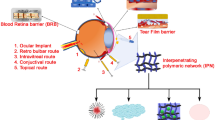Abstract
Enhanced drug partitioning in hydrogels can be achieved by configurational biomimetic imprinting (CBIP) techniques which involve the formation of pre-polymerization complexes between template molecules and functional monomers with specific chemical structures designed to interact with the template via non-covalent chemistry. This new class of recognitive intelligent materials is designed by incorporating motifs with structural and molecular homology to biological receptors and has a strong potential to impact the administration of a number of ocular therapies.
This work addresses the unmet need for the controlled release of histamine antagonists such as ketotifen fumarate on the surface of the eye to treat allergic conjunctivitis. Mast cell and eosinophil degranulation occurs due to the IL-4 driven TH2 cell response to allergens and the subsequent IgE secretion. This prompts the release of inflammatory mediators such as histamine, which binds to the H1-receptors. Pharmacological downregulation is possible by the local delivery of H1-antihistamines, resulting in decreased vascular permeability, bronchodilation, and exudation of effector cells.
Treatment options for seasonal and perennial allergic conjunctivitis primarily consist of oral antihistamines (which provide only partial and delayed relief with potential systemic side effects) and topical treatments. Since ocular bioavailability of topical drugs is very poor (typically less than 7% is absorbed by the eye), a high dosage is needed which prohibits contact lens use. Controlling and tailoring the release of anti-histamines via novel recognitive contact lenses with significantly enhanced partitioning can solve these problems with increased bioavailability, less irritation to ocular tissue, and reduced ocular and systemic side effects. Controlled release by conventional soft contact lenses typically does not work due to a lack of sufficient drug loading.
Inspired by Nature, we have successfully synthesized and characterized recognitive networks for H1 antihistamines by choosing monomers on the basis of the non-covalent interactions found in histamine docking sites. This leads to significantly enhanced drug loading and tailorable controlled release of a therapeutically viable dosage of drug.
Similar content being viewed by others
References
K. Park, Controlled Drug Delivery: Challenges and Strategies, ACS, Washington, D.C., 1997.
N.A. Peppas, Hydrogels in Medicine and Pharmacy, CRC Press, Boca Raton, FL, 1987.
M.F. Refojo. Ophthalmologic Applications. In Biomaterials Science, Ratner, B.D., Hoffman, A.S., Schoen, F.J., and Lemons, J.E., Eds.; Academic Press: San Diego, 1996; 328–335.
M.R. Jain, Br. J. Ophthalmol. 72, 150–154 (1988).
J.M. Chapman, L. Cheeks, K. Green, J. Cataract Refract. Surg. 18, 456–459 (1992).
C.Alvarez-Lorenzo, H. Hiratani, J.L Gomez-Amoza, R. Martinez-Pacheco, C. Souto, A. Concheiro. Journal of Pharmaceutical Sciences 91(10), 2182–2192 (2002).
H. Hiratani, C.Alvarez-Lorenzo, Journal of Controlled Release 86, 253–265 (2003).
J.Z. Hilt, N.A. Peppas, M.E. Byrne, Adv. Drug Deliver. Rev. 56(11), 1599–1620 (2004).
M.E. Byrne, K. Park and N.A. Peppas, Adv. Drug Deliver. Rev. 54, 149 (2002).
Author information
Authors and Affiliations
Rights and permissions
About this article
Cite this article
Venkatesh, S., Sizemore, S. & Byrne, M. Biomimetic Recognitive Polymer Networks for Ocular Delivery of Anti-Histamines. MRS Online Proceedings Library 897, 407 (2005). https://doi.org/10.1557/PROC-0897-J04-07
Published:
DOI: https://doi.org/10.1557/PROC-0897-J04-07




